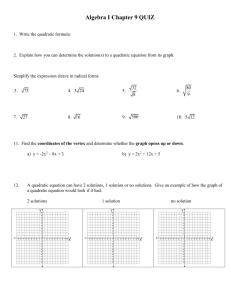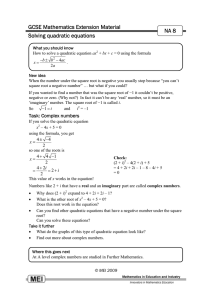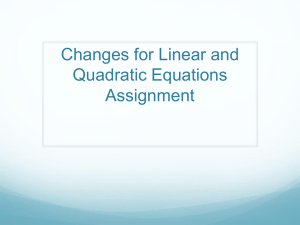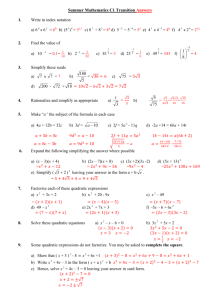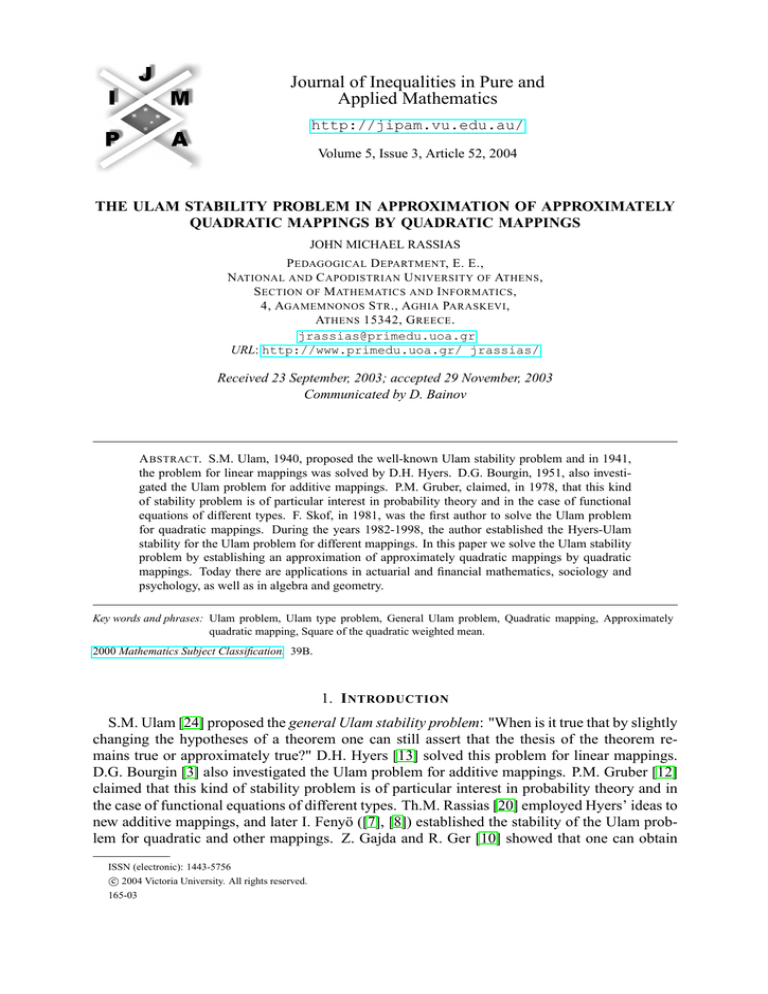
Journal of Inequalities in Pure and
Applied Mathematics
http://jipam.vu.edu.au/
Volume 5, Issue 3, Article 52, 2004
THE ULAM STABILITY PROBLEM IN APPROXIMATION OF APPROXIMATELY
QUADRATIC MAPPINGS BY QUADRATIC MAPPINGS
JOHN MICHAEL RASSIAS
P EDAGOGICAL D EPARTMENT, E. E.,
NATIONAL AND C APODISTRIAN U NIVERSITY OF ATHENS ,
S ECTION OF M ATHEMATICS AND I NFORMATICS ,
4, AGAMEMNONOS S TR ., AGHIA PARASKEVI ,
ATHENS 15342, G REECE .
jrassias@primedu.uoa.gr
URL: http://www.primedu.uoa.gr/ jrassias/
Received 23 September, 2003; accepted 29 November, 2003
Communicated by D. Bainov
A BSTRACT. S.M. Ulam, 1940, proposed the well-known Ulam stability problem and in 1941,
the problem for linear mappings was solved by D.H. Hyers. D.G. Bourgin, 1951, also investigated the Ulam problem for additive mappings. P.M. Gruber, claimed, in 1978, that this kind
of stability problem is of particular interest in probability theory and in the case of functional
equations of different types. F. Skof, in 1981, was the first author to solve the Ulam problem
for quadratic mappings. During the years 1982-1998, the author established the Hyers-Ulam
stability for the Ulam problem for different mappings. In this paper we solve the Ulam stability
problem by establishing an approximation of approximately quadratic mappings by quadratic
mappings. Today there are applications in actuarial and financial mathematics, sociology and
psychology, as well as in algebra and geometry.
Key words and phrases: Ulam problem, Ulam type problem, General Ulam problem, Quadratic mapping, Approximately
quadratic mapping, Square of the quadratic weighted mean.
2000 Mathematics Subject Classification. 39B.
1. I NTRODUCTION
S.M. Ulam [24] proposed the general Ulam stability problem: "When is it true that by slightly
changing the hypotheses of a theorem one can still assert that the thesis of the theorem remains true or approximately true?" D.H. Hyers [13] solved this problem for linear mappings.
D.G. Bourgin [3] also investigated the Ulam problem for additive mappings. P.M. Gruber [12]
claimed that this kind of stability problem is of particular interest in probability theory and in
the case of functional equations of different types. Th.M. Rassias [20] employed Hyers’ ideas to
new additive mappings, and later I. Fenyö ([7], [8]) established the stability of the Ulam problem for quadratic and other mappings. Z. Gajda and R. Ger [10] showed that one can obtain
ISSN (electronic): 1443-5756
c 2004 Victoria University. All rights reserved.
165-03
2
J OHN M ICHAEL R ASSIAS
analogous stability results for subadditive multifunctions. Other interesting stability results have
been achieved also by the following authors: J. Aczél [1], C. Borelli and G.L. Forti ([2], [9]),
P.W. Cholewa [4], St. Czerwik [5], H. Drljevic [6] and L. Paganoni [14]. F. Skof ([21] – [23])
was the first author to solve the Ulam problem for quadratic mappings. We ([15] – [19]) solved
the above Ulam problem for different mappings. P. Gǎvruţǎ [11] answered a question of ours
[17] concerning the stability of the Cauchy equation. Today there are applications in actuarial
and financial mathematics, sociology and psychology, as well as in algebra and geometry.
In this paper we introduce the following quadratic functional equation
(∗)
Q(a1 x1 + a2 x2 ) + Q(a2 x1 − a1 x2 ) = a21 + a22 [Q(x1 ) + Q(x2 )]
with quadratic mappings Q : X → Y such that X and Y are real linear spaces.
Denote
Kr = Kr (kx1 k , kx2 k)
= 2r−1 (kx1 kr + kx2 kr ) − (kx1 + x2 kr + kx1 − x2 kr )
r
r
r
r
2r−1 (kx1 k + kx2 k ) − (kx1 + x2 k + kx1 − x2 k ) , if r > 2
=
kx + x kr + kx − x kr − 2r−1 (kx kr + kx kr ) ,
if 1 < r < 2,
1
2
1
2
1
2
for every (x1 , x2 ) ∈ X 2 , where X is a normed linear space. Note that Kr ≥ 0 for any fixed real
r : 1 < r 6= 2. Note also that
Kr = Kr (kxk , kxk) = 0,
Kr
Kr (|a1 | kxk , |a2 | kxk) = β1 kxkr ,
m−1 |a1 | kxk , m−1 |a2 | kxk = β1 m−r kxkr ,
Kr
Kr (kxk , 0) = β2 kxkr and
m−1 kxk , 0 = β3 kxkr ,
where
β1 = Kr (|a1 | , |a2 |)
= 2r−1 (|a1 |r + |a2 |r ) − (|a1 + a2 |r + |a1 − a2 |r )
r
r
r
r
2r−1 (|a1 | + |a2 | ) − (|a1 + a2 | + |a1 − a2 | ) , if r > 2
=
|a + a |r + |a − a |r − 2r−1 (|a |r + |a |r ) ,
if 1 < r < 2,
1
2
1
2
1
2
r−1
− 2, if r > 2
r−1
2
β2 = Kr (1, 0) = 2
− 2 =
2 − 2r−1 , if 1 < r < 2,
β3 = Kr m−1 , 0 = β2 m−r ,
Note that a1 6= a2 , and 1 6= m = a21 + a22 > 0.
If X and Y are normed linear spaces and Y complete, then we establish an approximation of
approximately quadratic mappings f : X → Y by quadratic mappings Q : X → Y , such that
the corresponding approximately quadratic functional inequality
f (a1 x1 + a2 x2 ) + f (a2 x1 − a1 x2 ) − a21 + a22 [f (x1 ) + f (x2 )]
(∗∗)
≤ cKr (kx1 k , kx2 k)
J. Inequal. Pure and Appl. Math., 5(3) Art. 52, 2004
http://jipam.vu.edu.au/
T HE U LAM S TABILITY P ROBLEM I N A PPROXIMATION O F A PPROXIMATELY Q UADRATIC M APPINGS B Y Q UADRATIC M APPINGS
3
holds with a constant c ≥ 0 (independent of x1 ,x2 ∈ X), and any fixed pair a = (a1 , a2 ) ∈
R2 − {(0, 0)} and any fixed real r > 1 :
I1 = {(r, m) ∈ R2 : 1 < r < 2, m > 1 and r > 2, 0 < m < 1}, or
I2 = {(r, m) ∈ R2 : 1 < r < 2, 0 < m < 1 and r > 2, m > 1},
hold, where 1 6= m = a21 + a22 = |a|2 > 0 and a1 6= a2 . Note that mr−2 < 1 if (r, m) ∈ I1 , and
m2−r < 1 if (r, m) ∈ I2 .
It is useful for the following, to observe that, from (∗) with x1 = x2 = 0, and 0 < m 6= 1 we
get
2(m − 1)Q(0) = 0,
or
Q(0) = 0.
(1.1)
Definition 1.1. Let Xand Y be real linear spaces. Let a = (a1 , a2 ) ∈ R2 − {(0, 0)} : 0 < m =
a21 + a22 6= 1 and a1 6= a2 . Then a mapping Q : X → Y is called quadratic with respect to a, if
(∗) holds for every vector (x1 , x2 ) ∈ X 2 .
Definition 1.2. Let Xand Y be real linear spaces. Let a = (a1 , a2 ) ∈ R2 − {(0, 0)} : 0 < m =
a21 + a22 6= 1 and a1 6= a2 . Then a mapping Q̄ : X → Y is called the square of the quadratic
weighted mean of Q with respect to a = (a1 , a2 ), if
Q(a1 x)+Q(a2 x)
,
if (r, m = a21 + a22 ) ∈ I1
a21 +a22
(1.2)
Q̄(x) =
h i
(a2 + a2 ) Q
a1
a2
x
+
Q
x
, if (r, m = a21 + a22 ) ∈ I2
1
2
a2 +a2
a2 +a2
1
2
1
2
for all x ∈ X.
For every x ∈ R set Q(x) q
= x2 . Then the mapping Q̄ : R → R is quadratic, such
that Q̄ (x) = x2 . Denoting by x2w the quadratic weighted mean, we note that the abovementioned mapping Q is an analogous case to the square of the quadratic weighted mean ema2 x2 +a2 x2
ployed in mathematical statistics: x2w = 1 a21 +a22 2 with weights w1 = a21 and w2 = a22 , data
1
2
x1 = x2 = x, and Q (ai x) = (ai x)2 , (i = 1, 2).
Now, claim that for n ∈ N0 = {0, 1, 2, . . . } that
( −2n
m Q(mn x), if (r, m) ∈ I1
(1.3)
Q(x) =
m2n Q(m−n x), if (r, m) ∈ I2 ,
for all x ∈ Xand n ∈ N0 .
For n = 0, it is trivial. From (1.1), (1.2) and (∗), with xi = ai x (i = 1, 2), we obtain
Q(mx) = m [Q(a1 x) + Q(a2 x)] ,
or
Q̄(x) = m−2 Q(mx),
(1.4)
if I1 holds. Besides from (1.1), (1.2) and (∗), with x1 = x, x2 = 0, we get
Q(a1 x) + Q(a2 x) = mQ(x),
or
(1.5)
J. Inequal. Pure and Appl. Math., 5(3) Art. 52, 2004
Q̄(x) = Q(x),
http://jipam.vu.edu.au/
4
J OHN M ICHAEL R ASSIAS
if I1 holds. Therefore from (1.4) and (1.5) we have
Q(x) = m−2 Q(mx),
(1.6)
which is (1.3) for n = 1, if I1 holds. Similarly, from (1.1), (1.2) and (∗), with xi =
(i = 1, 2), we obtain
ai
x
m
Q(x) = Q̄(x)
(1.7)
x
if I2 holds. Besides from (1.1), (1.2) and (∗), with x1 = m
, x2 = 0, we get
a a 2
1
Q
x +Q
x = mQ(m−1 x),
m
m
or
Q̄(x) = m2 Q(m−1 x)
(1.8)
if I2 holds. Therefore from (1.7) and (1.8) we have
Q(x) = m2 Q(m−1 x),
(1.9)
which is (1.3) for n = 1, if I2 holds.
Assume (1.3) is true and from (1.6), with mn x in place of x, we get:
2
(1.10)
Q mn+1 x = m2 Q(mn x) = m2 (mn )2 Q(x) = mn+1 Q(x).
Similarly, with m−n x in place of x, we get:
2
(1.11)
Q m−(n+1) x = m−2 Q(m−n x) = m−2 (m−n )2 Q(x) = m−(n+1) Q(x).
These formulas (1.10) and (1.11) by induction, prove formula (1.3).
2. Q UADRATIC F UNCTIONAL S TABILITY
Theorem 2.1. Let X and Y be normed linear spaces. Assume that Y is complete. Assume
in addition that mapping f : X → Y satisfies the functional inequality (∗∗). Define I1 =
{(r, m) ∈ R2 : 1 < r < 2, m > 1, or r > 2, 0 < m < 1}, and I2 = {(r, m) ∈ R2 : 1 < r < 2,
0 < m < 1, or r > 2, m > 1} for any fixed pair a = (a1 , a2 ) of reals ai 6= 0 (i = 1, 2) and
any fixed real r > 1 : 1 6= m = a21 + a22 = |a|2 > 0, a1 6= a2 . Besides define
0 < β1 = Kr (|a1 | , |a2 |)
= 2r−1 (|a1 |r + |a2 |r ) − (|a1 + a2 |r + |a1 − a2 |r )
r
r
r
r
2r−1 (|a1 | + |a2 | ) − (|a1 + a2 | + |a1 − a2 | ) , if r > 2
=
|a + a |r + |a − a |r − 2r−1 (|a |r + |a |r ) ,
if 1 < r < 2,
1
2
1
2
1
2
β2 = Kr (1, 0) = |2r−1 − 2|, and σ = β1 + mβ2 > 0. Also define
m−2n f (mn x), if (r, m) ∈ I1
fn (x) =
m2n f (m−n x), if (r, m) ∈ I
2
for all x ∈ X and n ∈ N0 = {0, 1, 2, . . . }.
Then the limit
(2.1)
J. Inequal. Pure and Appl. Math., 5(3) Art. 52, 2004
Q(x) = lim fn (x)
n→∞
http://jipam.vu.edu.au/
T HE U LAM S TABILITY P ROBLEM I N A PPROXIMATION O F A PPROXIMATELY Q UADRATIC M APPINGS B Y Q UADRATIC M APPINGS
5
exists for all x ∈ X and Q : X → Y is the unique quadratic mapping with respect to a =
(a1 , a2 ), such that
σc
(2.2)
kf (x)−Q(x)k ≤
kxkr
2
|m − mr |
σc/(m2 − mr ), if (r, m) ∈ I1
r
= kxk
σc/(mr − m2 ), if (r, m) ∈ I
2
holds for all x ∈ X and n ∈ N0 and c ≥ 0 (constant independent of x ∈ X).
Existence.
Proof. It is useful for the following, to observe that, from (∗∗) with x1 = x2 = 0 and 0 < m 6=
1, we get
2 |m − 1| kf (0)k ≤ 0,
or
f (0) = 0.
(2.3)
Now claim that for n ∈ N0
(2.4)
σc
n|r−2|
1
−
m
kxkr
2
r
|m − m |
σc
m2 −mr 1 − mn(r−2) , if (r, m) ∈ I1 : mr−2 < 1
= kxkr
σc
n(2−r)
1
−
m
, if (r, m) ∈ I2 : m2−r < 1.
r
2
m −m
kf (x)−fn (x)k ≤
For n = 0, it is trivial.
Define f¯ : X → Y , the square of the quadratic weighted mean of f with respect to a =
(a1 , a2 ) by replacing Q, Q̄ of (1.2) with f , f¯, respectively, as follows:
f (a1 x)+f (a2 x)
,
if (r, m = a21 + a22 = |a|2 ) ∈ I1
a21 +a22
(2.5) f¯(x) =
i
h
(a2 + a2 ) f
a2
a1
x
+
f
x
, if (r, m = a21 + a22 = |a|2 ) ∈ I2
1
2
a2 +a2
a2 +a2
1
2
1
2
for all x ∈ X.
From (2.3), (2.5) and (∗∗), with xi = ai x (i = 1, 2), we obtain
kf (mx)−m [f (a1 x)+f (a2 x)]k ≤ σc kxkr ,
or
−2
m f (mx)−f¯(x) ≤ β1 c kxkr ,
m2
if I1 holds. Besides from (2.3), (2.5) and (∗∗), with x1 = x, x2 = 0, we get
(2.6)
kf (a1 x)+f (a2 x)−mf (x)k ≤ cKr (kxk , 0) = β2 c kxkr ,
or
f¯(x)−f (x) ≤ β2 c kxkr ,
m
if I1 holds. Therefore from (2.6) and (2.7) we have
σc
r−2
f (x) − m−2 f (mx) ≤ σc kxkr =
(2.8)
1
−
m
kxkr ,
2
2
r
m
m −m
which is (2.4) for n = 1, if I1 holds.
(2.7)
J. Inequal. Pure and Appl. Math., 5(3) Art. 52, 2004
http://jipam.vu.edu.au/
6
J OHN M ICHAEL R ASSIAS
Similarly, from (2.3), (2.5) and (∗∗), with xi = ami x (i = 1, 2), we obtain
f (x)−f¯(x) ≤ β1 c kxkr ,
(2.9)
mr
x
if I2 holds. Besides from (2.3), (2.5) and (∗∗), with x1 = m
, x2 = 0, we get
a a 1
2
x +f
x − mf (m−1 x) ≤ cKr m−1 kxk , 0 = β3 c kxkr ,
f
m
m
or
f¯(x)−m2 f (m−1 x) ≤ mβ3 c kxkr = mβ2 c kxkr ,
(2.10)
mr
if I2 holds. Therefore from (2.9) and (2.10) we have
σc
2−r
f (x)−m2 f (m−1 x) ≤ σc kxkr =
1
−
m
kxkr ,
(2.11)
r
r
2
m
m −m
which is (2.4) for n = 1, if I2 holds.
Assume (2.4) is true if (r, m) ∈ I1 . From (2.8), with mn x in place of x, and the triangle
inequality, we have
(2.12)
kf (x) − fn+1 (x)k
= f (x) − m−2(n+1) f mn+1 x ≤ f (x) − m−2n f (mn x) + m−2n f (mn x) − m−2(n+1) f mn+1 x nr σc
n(r−2)
−2n
r−2
≤ 2
1
−
m
+
m
1
−
m
m kxkr
r
m −m
σc
(n+1)(r−2)
1
−
m
kxkr ,
= 2
r
m −m
if I1 holds.
Similarly assume (2.4) is true if (r, m) ∈ I2 . From (2.11), with m−n x in place of x, and the
triangle inequality, we have
(2.13)
kf (x) − fn+1 (x)k
= f (x) − m2(n+1) f m−(n+1) x ≤ f (x) − m2n f m−n x + m2n f (m−n x) − m2(n+1) f m−(n+1) x σc
n(2−r)
2n
2−r
−nr
≤ r
(1
−
m
)+m
(1
−
m
)m
kxkr
2
m −m
σc
(n+1)(2−r)
= r
1
−
m
kxkr ,
2
m −m
if I2 holds.
Therefore inequalities (2.12) and (2.13) prove inequality (2.4) for any n ∈ N0 .
Claim now that the sequence {fn (x)} converges. To do this it suffices to prove that it is a
Cauchy sequence. Inequality (2.4) is involved if (r, m) ∈ I1 . In fact , if i > j > 0, and
h1 = mj x, we have:
(2.14)
kfi (x) − fj (x)k = m−2i f (mi x) − m−2j f (mj x)
= m−2j m−2(i−j) f mi−j h1 − f (h1 )
σc
(i−j)(r−2)
≤ m−2j 2
1
−
m
kxkr
r
m −m
σc
< 2
m−2j kxkr −−−→ 0,
j→∞
m − mr
if I1 holds: mr−2 < 1.
J. Inequal. Pure and Appl. Math., 5(3) Art. 52, 2004
http://jipam.vu.edu.au/
T HE U LAM S TABILITY P ROBLEM I N A PPROXIMATION O F A PPROXIMATELY Q UADRATIC M APPINGS B Y Q UADRATIC M APPINGS
7
Similarly, if h2 = m−j x in I2 , we have:
(2.15)
kfi (x) − fj (x)k = m2i f (m−i x) − m2j f (m−j x)
= m2j m2(i−j) f m−(i−j) h2 − f (h2 )
σc
(i−j)(2−r)
kxkr
≤ m2j r
1
−
m
2
m −m
σc
< r
m2j kxkr −−−→ 0,
j→∞
m − m2
if I2 holds: m2−r < 1.
Then inequalities (2.14) and (2.15) define a mapping Q : X → Y , given by (2.1).
Claim that from (∗∗) and (2.1) we can get (∗), or equivalently that the afore-mentioned welldefined mapping Q : X → Y is quadratic.
In fact, it is clear from the functional inequality (∗∗) and the limit (2.1) for (r, m) ∈ I1 that
the following functional inequality
m−2n kf (a1 mn x1 + a2 mn x2 ) + f (a2 mn x1 − a1 mn x2 ) −(a21 + a22 ) [f (mn x1 ) + f (mn x2 )]
≤ m−2n cKr (mn kx1 k , mn kx2 k) ,
holds for all vectors (x1 , x2 ) ∈ X 2 , and all n ∈ N with fn (x) = m−2n f (mn x) : I1 holds.
Therefore
h
i
lim fn (a1 x1 + a2 x2 ) + lim fn (a2 x1 − a1 x2 ) − (a21 + a22 ) lim fn (x1 ) + lim fn (x2 ) n→∞
n→∞
n→∞
n→∞
n(r−2)
≤ lim m
cKr (kx1 k , kx2 k) = 0,
n→∞
because mr−2 < 1 or
Q(a1 x1 + a2 x2 )+Q(a2 x1 − a1 x2 )− a21 + a22 [Q(x1 )+Q(x2 )] = 0,
(2.16)
or mapping Q satisfies the quadratic equation (∗).
Similarly, from (∗∗) and (2.1) for (r, m) ∈ I2 we get that
m2n f (a1 m−n x1 + a2 m−n x2 )+f (a2 m−n x1 − a1 m−n x2 )
−(a21 + a22 ) f (m−n x1 )+f (m−n x2 ) ≤ m2n cKr m−n kx1 k , m−n kx2 k ,
holds for all vectors (x1 , x2 ) ∈ X 2 , and all n ∈ N with fn (x) = m2n f (m−n x) : I2 holds. Thus
h
i
lim fn (a1 x1 + a2 x2 )+ lim fn (a2 x1 − a1 x2 ) − (a21 + a22 ) lim fn (x1 )+ lim fn (x2 ) n→∞
n→∞
n→∞
n→∞
≤ lim mn(2−r) cKr (kx1 k , kx2 k) = 0,
n→∞
because m2−r < 1, or (2.16) holds or mapping Q satisfies (∗).
Therefore (2.16) holds if Ij (j = 1, 2) hold or mapping Q satisfies (∗), completing the proof
that Q is a quadratic mapping in X.
It is now clear from (2.4) with n → ∞, as well as formula (2.1) that (2.2) holds in X. This
completes the existence proof of the above Theorem 2.1.
Uniqueness
Let Q0 : X → Y be a quadratic mapping satisfying (2.2), as well as Q. Then Q0 = Q.
J. Inequal. Pure and Appl. Math., 5(3) Art. 52, 2004
http://jipam.vu.edu.au/
8
J OHN M ICHAEL R ASSIAS
Proof. Remember both Q and Q0 satisfy (1.3) for (r, m) ∈ I1 , too. Then for every x ∈ X and
n ∈ N,
(2.17)
kQ(x) − Q0 (x)k = m−2n Q(mn x) − m−2n Q0 (mn x)
≤ m−2n {kQ(mn x) − f (mn x)k + kQ0 (mn x) − f (mn x)k}
2σc
≤ m−2n 2
kmn xkr
r
m −m
2σc
= mn(r−2) 2
kxkr → 0, as n → ∞,
m − mr
if I1 holds: mr−2 < 1.
Similarly for (r, m) ∈ I2 , we establish
(2.18) kQ(x) − Q0 (x)k = m2n Q(m−n x) − m2n Q0 (m−n x)
≤ m2n Q(m−n x) − f (m−n x) + Q0 (m−n x) − f (m−n x)
2σc m−n xr
≤ m2n r
m − m2
2σc
kxkr → 0, as n → ∞,
= mn(2−r) r
m − m2
if I2 holds: m2−r < 1.
Thus from (2.17), and (2.18) we find Q(x) = Q0 (x) for all x ∈ X.
This completes the proof of the uniqueness and stability of equation (∗).
Open Problem. What is the situation in the above Theorem 2.1 in case r = 2?
R EFERENCES
[1] J. ACZÉL, Lectures on Functional Equations and Their Applications, Academic Press, New York
and London, 1966.
[2] C. BORELLI AND G.L. FORTI, On a general Hyers-Ulam stability result, Internat. J. Math. Math.
Sci., 18 (1995), 229–236.
[3] D.G. BOURGIN, Classes of transformations and bordering transformations, Bull. Amer. Math. Soc.,
57 (1951),223-237 .
[4] P.W. CHOLEWA, Remarks on the stability of functional equations, Aequationes Math., 27 (1984),
76–86.
[5] ST. CZERWIK, On the stability of the quadratic mapping in normed spaces , Abh. Math. Sem. Univ.
Hamburg, 62 (1992), 59–64 .
[6] H. DRLJEVIC, On the stability of the functional quadratic on A-orthogonal vectors, Publ. Inst.
Math. (Beograd) (N.S.), 36(50) (1984), 111–118.
[7] I. FENYÖ, Osservazioni su alcuni teoremi di D.H. Hyers, Istit. Lombardo Accad. Sci. Lett. Rend.,
A 114 (1980), 235–242 (1982).
[8] I. FENYÖ, On an inequality of P.W. Cholewa, in General Inequalities, 5. [Internat. Schriftenreihe
Numer. Math., Vol. 80]. Birkhauser, Basel-Boston, MA, 1987, pp. 277–280.
[9] G.L. FORTI, Hyers-Ulam stability of functional equations in several variables, Aequationes Mathematicae, 50 (1995), 143–190 .
[10] Z. GAJDA AND R. GER, Subadditive multifunctions and Hyers-Ulam stability, in General inequalities, 5. [Internat. Schriftenreihe Numer. Math., Vol. 80]. Birkhauser, Basel-Boston, MA, 1987.
J. Inequal. Pure and Appl. Math., 5(3) Art. 52, 2004
http://jipam.vu.edu.au/
T HE U LAM S TABILITY P ROBLEM I N A PPROXIMATION O F A PPROXIMATELY Q UADRATIC M APPINGS B Y Q UADRATIC M APPINGS
9
[11] P. GAVRUTA, An answer to a question of John M. Rassias concerning the stability of Cauchy
equation, in Advances in Equations and Inequalities, Hadronic Math. Series, U.S.A , 1999, pp.
67–71.
[12] M. GRUBER, Stability of isometries, Trans. Amer. Math. Soc., U.S.A., 245 (1978), 263–277.
[13] D.H. HYERS, On the stability of the linear functional equation, Proc. Nat. Acad. Sci., 27 (1941),
222–224; The stability of homomorphisms and related topics, "Global Analysis-Analysis on Manifolds", Teubner - Texte zur Mathematik, 57 (1983), 140–153.
[14] L. PAGANONI, Soluzione di una equazione funzionale su dominio ristretto, Boll. Un. Mat. Ital.,
(5) 17-B (1980), 979–993.
[15] J.M. RASSIAS, On approximation of approximately linear mappings by linear mappings, J. Funct.
Anal., 46 (1982), 126–130.
[16] J.M. RASSIAS, On approximation of approximately linear mappings by linear mappings, Bull. Sc.
Math., 108 (1984), 445–446.
[17] J.M. RASSIAS, Solution of a problem of Ulam, J. Approx. Th., 57 (1989), 268–273.
[18] J.M. RASSIAS, On the stability of the general Euler-Lagrange functional equation, Demonstr.
Math., 29 (1996), 755–766.
[19] J.M. RASSIAS, Solution of the Ulam stability problem for Euler-Lagrange quadratic mappings, J.
Math. Anal. & Applics., 220(1998), 613–639 .
[20] TH.M. RASSIAS, On the stability of linear mappings in Banach spaces, Proc. Amer. Math. Soc.,72
(1978), 297–300.
[21] F. SKOF, Proprieta locali e approssimazione di operatori. In Geometry of Banach spaces and related
topics (Milan, 1983). Rend. Sem. Mat. Fis. Milano, 53 (1983), 113–129 (1986).
[22] F. SKOF, Approssimazione di funzioni δ-quadratiche su dominio ristretto, Atti Accad. Sci. Torino
Cl. Sci. Fis. Mat. Natur., 118 (1984), 58–70.
[23] F. SKOF, On approximately quadratic functions on a restricted domain, in Report of the third International Symposium of Functional Equations and Inequalities, 1986. Publ. Math. Debrecen, 38
(1991), 14.
[24] S.M. ULAM, A Collection of Mathematical Problems, Interscience Publishers, Inc., New York,
1968, p. 63.
J. Inequal. Pure and Appl. Math., 5(3) Art. 52, 2004
http://jipam.vu.edu.au/




